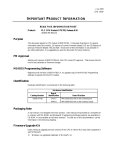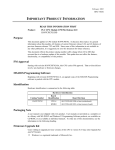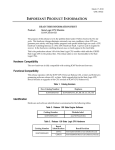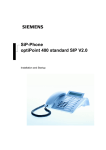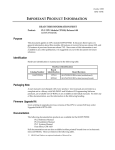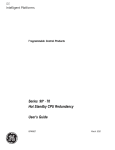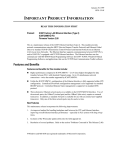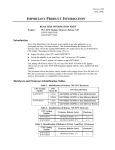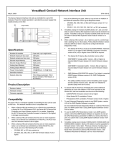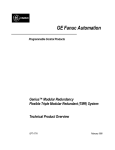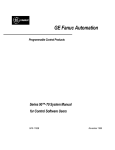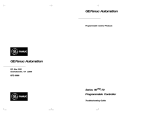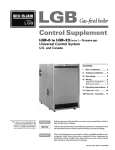Download IPI, PLC CPU Module, GFK
Transcript
Restarts for autonumbers that do not restart in each chapter. figure bi level 1, reset table_big level 1, reset chap_big level 1, reset app_big level 1, reset figure_ap level 1, reset table_ap level 1, reset figure level 1, reset table level 1, reset these restarts must be in the header frame of chapter 1. a:ebx, l 1 resetA a:obx:l 1, resetA a:bigbx level 1 resetA a:ftr level 1 resetA c:ebx, l 1 reset1 c:obx:l 1, reset1 c:bigbx level 1 reset1 c:ftr level 1 reset1 Reminders for autonumbers that need to be restarted manually (first instance will always be 4) let_in level 1: A. B. C. letter level 1:A.B.C. num level 1: 1. 2. 3. num_in level 1: 1. 2. 3. rom_in level 1: I. II. III. roman level 1: I. II. III. steps level 1: 1. 2. 3. July 15, 1996 GFK-1289B IMPORTANT PRODUCT INFORMATION READ THIS INFORMATION FIRST Product: PLC CPU Module IC697CPM790-BB This is the production release of the IC697 PLC CPU module, Model 790, version 6.02 which is used in IC66* (IC660 or IC661) Modular Redundancy (GMR) systems. This release supports Phase III of the GMR system. It also fixes the problems listed under Problems Resolved by This Upgrade. In addition, several of the features provided in release 6.00 of the standard IC697 CPU modules are also available in the GMR CPU’s (see New Features and Functionality). Table 1. Catalog Numbers New Catalog Number Replaces IC697CPM790-BB IC697CPM790AA, BA Identification Hardware and software identification is summarized in the following tables. Table 2. Hardware Identification Catalog Number Board Identification IC697CPM790-BB CPVA1 44A732261-G01 R04 or later (mother board) CMVA1 44A735200-G01 R03 or later (memory board) Board Revision Table 3. Firmware Identification Catalog Number IC697CPM790-BB EPROM Location n/a U45 EPROM/Diskette Label 44S750522-G01 R02 (3”) 388-042A2.0 Packaging Note The user manual is not shipped with every product. User manuals are provided as a complete set in a library with IC641 Programming Software products, are available on CD-ROM, or can be ordered as individual manuals. Important Product Information: PLC CPU Module 2 GFK-1289B July 15, 1996 Update Information No update kits are available for this product. For those customers who purchased a version 6.01 CPM790, a version 6.02 upgrade is available on the Electronic Bulletin Board. The files necessary for a CPM790 upgrade have been ZIP’ed into a single self-extracting .EXE file and placed in the PLC:PUBLIC conference and the PLC:Series 90-70 directory. The Bulletin Board entry for this update file contains information explaining what the file is and how to create a master update diskette using the file. For those customers who have access to the Electronic Bulletin Board, updates for the CPM790 CPU can be obtained by downloading the appropriate .EXE file. There is no charge for updates obtained in this manner. Table 5. Bulletin Board Filename for CPM790 Firmware Updates Upgrade Kit For Upgrading To CPM79602.EXE IC697CPM790-AA, BA IC697CPM790-BB Note Ensure that you download the correct.EXEfile.CPM914/915/924/925 firmware will not work on a CPM790. Documentation The following table lists the applicable documentation for the IC697CPM790 CPU. Table 6. User Documentation Catalog Number IC697CPM790-BB Data Sheet User Manual GFK-1215 see below Full Documentation Sets Full documentation sets are also available in either printed/bound form or in electronic form (CD-ROM). Refer to the following table for ordering information for full documentation sets. Table 7. Full Documentation Set Catalog Number Description IC697LBR701* Paper library - full set of printed manuals IC690CDR002* CD-ROM - full set of manuals in electronic format * Current version will be shipped. Read this document before installing or attempting to use the IC697CPM790 PLC CPU Module. For more information, refer to the applicable Programmable Controller Installation manual, Programming Software User’s Manual, Programmable Controller Reference Manual, and the IC66* Modular Redundancy Flexible Triple Modular Redundant (TMR) System). 3 Important Product Information: PLC CPU Module GFK-1289B July 15, 1996 Special Operation Notes IC641 Compatibility This release of the PLC Model 790 CPU module requires IC641 programming software, version 6.02, or later to gain access to all of the CPU’s features and functionality. CPU Model IC641 Programming Software IC697CPM790 Version 6.02 or later If Release 6.02 PLC CPU firmware is used with IC641 programming software Release 4.01 or 4.02, the PLC Sweep Control and Monitor screen (F3 F8) should ONLY be used to change (tune) the constant window or constant sweep time. Any other use may result in the background window time being incorrectly set to 255 milliseconds. For those IC641 programming software releases used with a Release 6.02 CPU, the configuration package must be used to set the desired sweep modes or window times. Microcycle Mode and First Output Scan Microcycle mode is a new sweep mode beginning with Release 6.00 CPUs. In this mode, the PLC keeps the time interval between I/O scans constant (for a further description of Microcycle mode see New Features and Functionality, Microcycle Sweep Mode) – actually the start of sweep time is maintained as a fixed interval. In keeping the time interval between I/O scans constant, the CPU must know the amount of the sweep to be allocated to the output scan. Under normal operating situations, the amount of time required to complete the previous sweep’s output scan is used to estimate the amount of time required to complete this sweep’s output scan. Obviously, this manner of estimating the amount of time required for the output scan does not work for the first output scan of the IC697 PLC. Since no previous sweep’s output scan time is available, the Release 6.xx CPU will estimate the output scan time based upon the configured base cycle time. The first output scan will be estimated as one-third of the configured base cycle time. (for example, if the base cycle time is configured to be 60 milliseconds, then the first output scan will be estimated as requiring 20 milliseconds). When programming for first scan, ensure that the logic to be performed in a given program will complete prior to the next execution time for that same program. PCM and BTM Compatibility With the introduction of timing improvements and new features in Release 5.00, it is highly recommended that systems using PCMs use IC697PCM711J or later. It is also highly recommended that systems using BTMs use IC697BEM713B or later. Use of boards of an earlier revision may result in lower system performance. Important Product Information: PLC CPU Module 4 GFK-1289B July 15, 1996 PCM (to CPU) Communications Timeout The PCM has a default backplane communications timeout value of 5 seconds. After the PCM has sent a request to the IC697 CPU, the PCM applies this timeout while waiting on a response back from the CPU. In most cases, the CPU will respond well within the 5 second timeout, however, in certain instances the CPU can take longer than 5 seconds to respond. These cases are limited to LOADs and/or STOREs of program and/or configuration - especially if blocks in the program are larger than 8 KBytes. Folders containing EXE blocks (again with *.EXE files >8 KBytes) are most likely to cause problems. Beginning in Release 6.00 Standalone C programs larger than 8 Kbytes also cause this to happen. Note This problem may be encountered when using the CPM790 CPU in a TUV approved system. The GMR application code is a Standalone C program that is larger than 8 Kbytes. Beginning in Release 5.50 of the IC697 CPUs, the CPU is guaranteed to respond within 8 seconds. To ensure that the PCMs do not observe backplane timeouts, a file must be loaded (using termf) to the PCM. The file must be named CPU.ENV and is a binary file. The contents of this file are as follows (all values are specified in hexadecimal): FILE OFFSET 0000 DATA 4C 5A 01 01 00 00 00 00-00 00 00 00 01 00 00 00 LZ . . . . . . . . . . . . . . . . . . . . . . . .CPULIN 0010 00 00 00 00 00 00 00 00-00 00 43 50 55 4C 49 4E 0020 4B 2E 43 4F 44 00 2D 62-00 36 34 00 2D 74 00 32 K . C O D . –b . 6 4 .–t . 2 0030 30 30 00 00 43 50 55 4C-49 4E 4B 2E 44 43 42 00 0 0 . .C P U L I NK . D C B . 0040 00 4E 55 4C 4C 3A 00 4E-55 4C 4C 3A 00 4E 55 4C . N U L L: . N U L L : . N U L 0050 4C 3A 00 00 00 00 00 00-00 00 00 00 00 00 00 00 L : . . . . . . . . . . . . . . 0060 00 00 00 00 00 00 00 00-00 00 00 00 00 00 00 00 . . . . . . . . . . . . . . . . 0070 00 00 00 00 00 00 00 00-00 00 00 00 00 00 00 00 . . . . . . . . . . . . . . . . Once the binary file CPU.ENV (above) is created, use termf to load CPU.ENV to the PCM. Then execute a soft reset of the PCM. After executing the soft reset, the PCM’s backplane communications timeout should be 10 seconds. Note A copy of the above CPU.ENV file can be obtained from the Electronic Bulletin Board Service (BBS). CPU.ENV can be found in the conference:library of PLC:PCM and is named CPU.ENV. CAUTION The CPU.ENV file will not be used when a hard reset is performed on the PCM. With the CPU.ENV file resident in the PCM, a soft reset must be performed after every hard reset of the PCM. Be aware that it is possible to issue a soft reset COMMREQ from the Ladder Diagram application; therefore, the application can be modified to handle the required reset of PCMs after a power cycle of the PLC system 5 Important Product Information: PLC CPU Module GFK-1289B July 15, 1996 Notice to Upgrade GBC Hardware With the introduction of new features in CPU Release 5.00, timings with the IC66* Bus Controllers (GBCs/NBCs) have changed; this has uncovered a problem in the GBC/NBC firmware. GBCs/NBCs in expanded racks could be lost if the system is fully configured and only the main rack cycles power. Also, in previous versions of the GBC/NBC there was a problem with input data coherency. In a system with a large CPU sweep time and a short IC66* bus scan time a problem could be seen if a device is lost. Input data could be defaulted off while the CPU is reading the data from the GBC/NBC. It is recommended to update existing GBC/NBC hardware to IC697BEM731M or later when used with the CPM790 CPU. Operation of the IC697BEM731M will result in a slight increase to the I/O scan time of the PLC when compared to previous versions of the GBC/NBC hardware. Third Party VME Modules IC641 programming software Release 5.00 (and later) allows Third Party VME modules to be configured for six modes: NONE, INTERRUPT ONLY, BUS INTERFACE, FULL MAIL, I/O SCAN, and REDUCED MAIL. However, CPU Release 6.02 only supports NONE, BUS INTERFACE, FULL MAIL, and I/O SCAN modes. The other modes should not be configured. Maximum PLC Sweep In systems configured for IC66* Bus Redundancy a complete PLC sweep must be executed every 500 milliseconds or less, even though it is possible to configure the watchdog timer to higher limits. This also means that resetting of the watchdog timer with Service Request #8 cannot be done indefinitely. Serial Communications The following operating restrictions exist for the Serial Communications feature: 1. Serial communications can add up to 5 milliseconds of time to any given sweep. This should be taken into account when setting the watchdog timer. 2. The following procedure is recommended when changing baud rates in the PLC and the WSI board. First enter the configuration package and change the baud rate on the PLC, then store the new configuration. Now power off the PLC and then go to the WSI setup screen and change the WSI baud rate. Finally, power the PLC back on. 3. The link idle time setting in IC641 programming software Config for Serial Communications should be set to 10 seconds or greater. Otherwise a communications failure will occur when storing the config to the PLC. Serial Port Mode Configuration There is a serial port configuration parameter under software configuration for the PLC CPU called MODE. This configuration parameter can be one of two values: SNP to indicate that the serial port will be used for SNP communications, or MSG to Important Product Information: PLC CPU Module 6 GFK-1289B July 15, 1996 indicate that the serial port will be used to send printf commands from a C block (or Standalone C program) to the connected device. If you have configured MODE to be MSG and are also using serial IC641 programming software as a means of communicating with the PLC, communications with IC641 programming software is lost when going to the RUN mode, since the serial port is currently configured for printf commands from C blocks (or Standalone C programs). IC641/WSI Attach Do not connect or disconnect the WSI/BTM cable while the programmer host is powered-on. This action may cause a running PLC to Stop. Expansion Rack ID The expansion racks for the IC697 PLC are shipped with the rack ID strapped for rack 0 (the main rack). If the rack jumper is not changed the PLC will not recognize the rack at all and may not properly identify the error. Expansion Rack Cable Do not connect or disconnect the expansion rack cable while the CPU is running. This will cause the PLC to go to the STOP/HALT mode. Expansion Rack Power Expansion racks should be powered up at the same time that the main rack is powered up, or they should be powered up after the main rack has completed its power-up initialization. Do not power-up an expansion rack while the CPU is running power-up diagnostics. Memor y Usage A general rule-of-thumb for memory usage is 48 bytes per I/O point plus register memory in bytes. Timer Operation Care should be taken when timers (ONDTR, TMR, and OFDTR) are used in program blocks that are NOT called every sweep. The timers accumulate time across calls to the sub-block unless they are reset. This means that they function like timers operating in a program with a much slower sweep than the timers in the main program block. For program blocks that are inactive for large periods of time, the timers should be programmed in such a manner as to account for this catch up feature. Similar to this are timers that are skipped because of the use of the JUMP instruction. Timers that are skipped will NOT catch up and will therefore not accumulate time in the same manner as if they were executed every sweep. I/O Link Interface When powering up the PLC CPU without a battery, and I/O Link Interface boards are present, an incorrect Loss of Module fault will be logged for each I/O Link Interface board; but the PLC CPU will not consider these boards as lost, and the boards will continue to operate properly. 7 Important Product Information: PLC CPU Module GFK-1289B July 15, 1996 COMMREQs with Retentive Memory When powering up the PLC CPU with a program being retrieved from Retentive Memory and proceeding to RUN mode, any COMMREQs to a PCM should be delayed for 5 seconds. Constant Sweep Constant Sweep time, when used, should be set to about 10 milliseconds greater than the normal sweep time to avoid any oversweep conditions when monitoring or performing on-line changes with the programmer. The smallest valid constant sweep time setting is 10 milliseconds for the CPM790 CPU. Window completion faults will occur if the constant sweep setting is not high enough. Interaction of IC641 Programming Software with Closed Programming Window The IC641 programming software Sweep Control and Monitor screen cannot be used to change the PLC Sweep Modes or timers (Constant Sweep Time, Program Window Times, etc.) while the program window is closed. Use Service Requests #1 through #4 to perform these functions. CPM790 Ambient Temperatures Due to the high power dissipation of the CPM790 CPU microprocessor, this module’s ambient temperature during operation must be kept at or below 40 C (104 F). With Forced air cooling, the module can operate at 60 C (140 F). Rack Fan Assemblies IC697ACC721 (120 VAC) and IC697ACC724 (240 VAC) for forced air cooling are available for direct mounting on the IC697 rack. SFC RESET Function When programming using SFC, no logic can appear to the right of an SFC_RESET function block. External Devices Writing to CPU Memory At CPU power-up, the CPM790 CPU prohibits external devices (PCMs, Ethernet boards, CMMs, and others) from having write access into PLC memory (config data, program code, %R, %P, %L, %I, %Q, %AI, %AQ, %T, %M, %G (including %GA – %GE, and so forth). The only devices that are permitted write access are: parallel IC641 programming software, anything through the built-in CPU serial port, and IC66* bus controllers. If external devices require write access to portions of memory, these writable areas may be made available by the application using Service Request #31. This new Service Request (#31) permits a range within each memory reference type to be defined as writable by external devices. (Service Request #31 does not require that every memory reference type have a writable area, but does limit the writable area to a single, contiguous range in each memory reference type that is specified). Note This restriction prevents the use of any Ethernet version of IC641 programming software to store and/or modify application programs. The serial or WSI versions of IC641 programming software must be used to store and/or modify application programs. Important Product Information: PLC CPU Module 8 GFK-1289B July 15, 1996 Problems Resolved by This Upgrade 1. The Service Request function block, when processing request #20, took an exceptionally long time to complete (10+ milliseconds). 2. Occasionally the CPU would not perform its full power-up diagnostic checks even when powering up into STOP mode. 3. The Service Request function block function code #21 incorrectly permitted use of error codes greater than 800h. Such error codes are interpreted by the PLC CPU as being Remote Scanner alarms. 4. An IC660/661 Bus Fault could have set the fault condition for the M_rsbmm (r=rack, s=slot, b=bus, mm=SBA of GBC/NBC) fault and nofault contacts. This fault condition would persist until either the fault tables were cleared or the GBC/NBC’s rack was power-cycled. 5. Expansion rack Analog Input Expander cards were reset (lights out) during a run mode reconfiguration. 6. In cases when a CPU rack was powered off and an expansion rack containing a PCM was then powered up, the PCM was given sufficient time to complete its self tests then timed out the CPU and proceeded into PCM standalone mode. If the CPU was then powered up, the PCM was not reset but no indication was given to the user that the PCM was not configured. 7. The CPU did not verify that interrupt trigger declarations in the program correctly corresponded to interrupt generating modules declared in the I/O configuration. 8. The Time of Day clock incorrectly handled leap year. 9. Attempting to read (from an external device) the %L memory associated with an EXE block resulted in the CPU lights going out. Subsequent power-up showed a PLC CPU Software Fault (error code 8D hex) in the PLC fault table. 10. When using SVCREQ function #20 to read the PLC or I/O fault tables, occasionally the header information returned and the current state of the fault tables was inconsistent. 11. Pre-release revision 6.00 CPUs occasionally did not always work with new IC697 power supplies. Problems could be observed when using PWR710E, PWR710F, and PWR724A. The symptoms were typically a loss of option module(s) in expansion rack(s). 12. After a power cycle of an expansion rack containing IC660/661 Bus Controllers, occasionally the IC697 CPU would timeout the reconfiguration of the GBC/NBCs that were powering up. 13. When the FIP Bus Controller logged a Loss of Device fault for a remote FIP subscriber at station address 127, ALL of the F_rsmmm [FAULT] contacts were set. When the corresponding Addition of Device fault was logged, ALL of the F_rsmmm [FAULT] contacts were cleared. This only happened with station address 127 (7F hexadecimal). 14. Rack and Slot Fault Locating References did not reflect the state of any FIP Locating References. 15. EVENT-TRIGGERED programs using %I memory as the trigger point set the wrong %I reference when the trigger occurs. This was not a problem for I/O interrupt blocks. Important Product Information: PLC CPU Module GFK-1289B 9 July 15, 1996 16. In rare circumstances the PLC logged a fatal PLC failure (fault group 0x87, error code 4) during a stopped mode store. When this occurred the CPU had to be cleared by powering up with the battery disconnected. 17. Transitional contacts and coils occurring in rungs solved following a MOVE_BIT instruction occasionally did not pass power flow. This occurred when the reference was within eight points below and eight points above the %Q output parameter range of the MOVE_BIT instruction. 18. Faults on FIP station address 127 caused all FIP device locating references to be set. 19. When an SFC_RESET function in an LD block was called from an SFC MAIN block and EN received power, the reset was NOT executed because it was in an LD block, but the OK output was enabled. Important Product Information: PLC CPU Module 10 GFK-1289B July 15, 1996 New Features and Functionality The New Features and Functionality listed below are those that first appeared in Release 6.00 and are also provided in Release 6.02 of the CPM790. Standalone C Program IC697 CPU Release 6.00 provides the ability to have PLC CPU applications written exclusively in the C language. A standalone C program is called from the operating system directly – no Ladder Logic is required. Each standalone C program (code and data) can be a maximum of 512 Kbytes, providing there is sufficient RAM available on the PLC CPU. A standalone C program can have up to eight input specifications and up to eight output specifications. Each input or output specification is defined as a start PLC memory reference and a data length. The input specifications are copied into the standalone C program when the standalone is scheduled for execution by the operating system. Output specifications are copied back to the specified PLC global memory upon completion of the standalone C program’s execution. Each of the input/output specifications are defined by the user through IC641 programming software Release 6.00. Standalone C programs are created using the C Programmer ’s Toolkit for IC697 PLCs (v3.00). For more information on Standalone C programs, please consult the Programmable Controller Reference Manual or C Programmer’s Toolkit for PLCs User’s Manual. Multiple Programs Release 6.00 of the IC697 PLC CPU now supports the storing of multiple programs to a single PLC. A maximum of 16 programs can be stored to the Release 6.00 IC697 CPU. Of the 16, only one can be a Ladder Logic/ SFC program. Therefore a Release 6.00 PLC CPU can take a maximum of one LD/SFC program and 15 Standalone C programs, or 16 Standalone C programs. The PLC CPU must still contain sufficient available User RAM to store all programs. Embedded Debugger for C Applications The IC697 CPU, beginning with Release 6.00, now includes a C debugger embedded in the CPU firmware. The embedded debugger is for use in debugging C applications running in the IC697 PLC CPU. Some of the capabilities provided by the embedded debugger include the setting of hardware and/or software breakpoints, establishing watch variables, display/edit C application data, single step execution of the C application, and step-over/step-intoexecution control. The embedded debugger can be used to debug C (EXE) blocks and Standalone C programs in the Release 6.00 IC697 PLC CPU. Only one debug session is permitted at any time. When debugging a C application, start/stop control of the program is controlled through the embedded debugger, however, the IC697 PLC continues to execute its sweep – executing any other program in the CPU, scanning I/O, communicating with IC641 programming software (if connected), and communicating with any option modules (if present). A new C Toolkit, the PLC C Toolkit Professional (IC641SWP719A), is required to use the embedded debugger. The new C Toolkit 11 Important Product Information: PLC CPU Module GFK-1289B July 15, 1996 provides the User Interface program for controlling the embedded debugger and the required communications drivers. Communications between the User Interface and the IC697 CPU is with SNP on the CPU’s built-in serial port. (Note: Debugger communications drivers and User Interface program are DOS-based applications). FIP I/O The Release 6.00 IC697 CPU now supports FIP I/O (a new type of I/O network) and the FIP Bus Controller (FBC). For more information on FIP I/O and the FIP Bus Controller please refer to the FIP Bus Controller User’s Manual. Microcycle Sweep Mode Microcycle is a new Sweep Mode of the Release 6.00 IC697 PLC CPU. In microcycle mode, each sweep begins at an absolute time relative to the STOP-to-RUN transition time. Programs are configured by the user to run at whole number intervals of the base cycle time. In microcycle mode the overall sweep is much like that of Constant Sweep, however, program execution can be time sliced over several sweeps. Higher priority (must run often) programs are given smaller intervals of the base cycle time, whereas lower priority (run less often) programs are given larger intervals. The interval defines how often the program will be scheduled for execution (for example, an interval of 1 indicates that this program must execute every sweep; an interval of 3 indicates that the program should be scheduled for execution every third sweep.) Programs with interval 1 must be scheduled and complete execution every sweep. Programs with intervals greater than 1 are scheduled based on their interval, but execution of any given program need only complete prior to its next interval time to be scheduled. A program with interval 2 does not necessarily run 1/2 the program in one sweep and 1/2 in the next, and a program with interval 3 does not necessarily run 1/3 of its execution across 3 sweeps. Note The prior execution of a given program must complete before that same program can be scheduled for its next execution. If the program did not complete its prior execution, then at the time is to be scheduled, a fault will be logged and the program will not be scheduled on this interval. Multiple SNP Sessions The Release 6.00 IC697 PLC CPU now supports multiple logical connections through the CPU’s built-in serial port. This functionality is provided in conjunction with the Host Communications Toolkits to permit multiple user applications running in the same host computer to communicate serially (SNP) with the IC697 CPU via the Host Communications Toolkits and an SNP driver. One Megabyte User Logic Memory The CPM790 CPU provides 1 Megabyte (1024 kilobytes) of User Logic memory. This CPU supports multiple programs with the restrictions that no single program can be larger than 512 Kbytes and only one LD/SFC program is permitted. IC641 programming software Release 6.00, or later is required to configure this CPU model. Important Product Information: PLC CPU Module 12 GFK-1289B July 15, 1996 FIP Device Status References (F_rsnnn) With the addition of FIP I/O to the Release 6.00 IC697 CPU, FIP device status references are included. These FIP device status references are analogous to the Module status references provided for use with IC66* bus based devices (M_rsbmm). FIP device status references take the form: F_rsnnn where: F indicates this is a FIP device status reference r indicates the VME rack number of the FIP Bus Controller s indicates the VME slot number of the FIP Bus Controller nnn indicates the node id of the FIP I/O nest The FIP device status references are to be used with the FAULT and NOFLT contacts to determine if an I/O nest on the FIP I/O network has a fault condition. Interrupt Blocks Calling Other Blocks Previous releases of the IC697 PLC CPU have not permitted calls to other blocks from within an LD block configured as an I/O or Timed Interrupt Block. This restriction has been removed with Release 6.00. 14-P oint Interrupt Module Support for the IC697 14-point Interrupt Module has been incorporated into the Release 6.00 IC697 PLC CPU. Use of the 14-point Interrupt Module with prior versions of the IC697 PLC CPU required application support from within the user’s logic program to interface with and control the 14-point Interrupt module. This support is now in the CPU firmware. Note When upgrading to IC697 CPU Release 6.00, the PLC logic associated with supporting the 14-point Interrupt Module MUST be removed from the application program prior to placing the Release 6.00 CPU into RUN mode. If this support logic is not removed, incorrect operation of the 14-point Interrupt Module, the application program, and the IC697 PLC CPU firmware will result. PID Function Block Version 6.02 firmware now provides support (based upon the PID function block configuration word) for anti-reset windup action. The PID configuration word permits you to select whether PID should back calculate the result (DEFAULT action) or pre-clamp reset hold. Refer to Additions to the PLC Reference Manual, for a detailed description of the updated PID function block configuration word. 13 Important Product Information: PLC CPU Module GFK-1289B July 15, 1996 Restrictions and Open Problems 1. If an expansion rack powers up while the CPU in the main rack is in the RUN mode, the slot fault contacts will prematurely indicate that the modules in the expansion rack are not faulted before they complete their power up. 2. In a multi-rack system, false LOSS OF RACK faults may occur when the system loses power. If this fault is configured to be fatal, the system will power-up in STOP mode. 3. When there is no logic stored in a CPU module the %Q and %M tables will be cleared when the CPU is placed in RUN mode. In this context no logic stored means that no program had ever been stored or that the clear function on the IC641 programming software had been used to clear logic and configuration. 4. When the Bit Sequencer sequences from one step to another, the negative transitional contact that corresponds to the original step is not set. The transition contact for the new step is set and remains set until the sequencer sequences to the next step. This operation is identical to the operation of the previous versions of the CPU firmware. 5. If multiple faults exist in an IC697 PLC remote drop and one of them is corrected, a FAULT contact that uses the remote drop’s module reference will incorrectly indicate that no faults exist at the remote drop. 6. An Analog Input Base module and its expander modules may not come online if they are configured in an expansion rack that is missing when the main rack powers up. Power-up the expansion rack first, then power-up the main rack. 7. If the main rack loses power during PLC configuration, analog input base boards (IC697ALG230) in expansion racks that do not lose power may fail. The failure would occur on the subsequent configuration. PLC configuration occurs during power up, store of configuration, and reads from Retentive (Flash) Memory. To prevent the failure, tie all racks to a common power source. To correct the failure, power-cycle the expansion racks. 8. If the CPU is to power-up into RUN mode the full power-up diagnostic tests are supposed to be skipped. If only an I/O configuration (no program) is stored to the PLC and the PLC is placed in RUN mode, then a power-cycle of the PLC will result in the CPU performing its full power-up diagnostic tests. 9. Care must be taken when using continuation coils/contacts in the main LD program execution and also in interrupt block execution. There is only one location in Bit Cache memory for storing the continuation coil value. Because of this do not use continuation coils/contacts in both main LD program and in interrupt blocks. 10. An incorrectly formatted COMMREQ (for example, incorrect task id field) directed to a PCM or CMM module does not result in an error being logged in the PLC fault table. Correctly formatted COMMREQs operate normally. Important Product Information: PLC CPU Module 14 GFK-1289B July 15, 1996 Additions to the PLC Reference Manual IC697 Instruction Set: SVCREQ #15 Page 4-214 of the G version of the Programmable Logic Controller Reference Manual provides a description of the returned data when a SVCREQ #15 is executed (read last fault). The number of bytes of meaningful fault specific data varies depending on whether the logged fault is long or short and also whether it is an I/O fault or a PLC fault. Referring to the fault table descriptions on page 4-213 and 4-214, the Long/Short indicator (in the least significant byte of word address + 1) defines the number of bytes of meaningful fault specific data present in the fault memory. Defined values are: Fault Table Type Long/Short Value PLC Fault Table 00 = 8 bytes (short) 01 = 24 bytes (long) I/O Fault Table 02 = 5 bytes (short) 03 = 21 bytes (long) IC697 Instruction Set: PID The PID function block has been enhanced in version 6.02 to make the anti-reset windup mechanism configurable. Prior to this release, the IC697 CPU would back calculate the reset term whenever the output is clamped. In version 6.02 this is now the DEFAULT mechanism. Alternatively, you can now choose to simply hold the reset term at its pre-clamp value. The advantage of the new mechanism is to reduce overshoot caused by the reset term as a result of a step change to the SP. Note The described changes in the PID config word were actually provided, but not documented, in version 6.01 IC697 CPU firmware. If you currently have version 6.01 firmware, the described anti-reset windup action of the PID function block is available. Example: A process is in steady state with PV=58 degrees. A batch is turned on and SP is jumped to 200 degrees. The output clamps high and, with the default anti-reset back calculation, the reset term is driven low to prevent the output from exceeding the clamp. When the PV comes up near the SP, the reset term is large and negative because of the back-calculation. This term must be integrated out, which takes times, so the process overshoots. The new method, if configured, would simply hold the original pre-clamp reset term, presumably small, so it does not take any time to integrate out, thereby reducing overshoot. Page 4-241 of the Programmable Logic Controller Reference Manual provides a description of the defined bits in the PID configuration word. This bit definition is contained in Table 4-4 PID Function Block Data. The configuration word has been enhanced in version 6.02 firmware to include support for an anti-reset windup action (as described above) and Table 4-4 on the following page shows the version 6.02 firmware definitions for the PID function Block configuration word. 15 Important Product Information: PLC CPU Module GFK-1289B July 15, 1996 Table 4-4. PID Function Block Data Data Item Config Word Description A word value with the following format: bit 0 = Error Term. When this bit is set to zero, the error term is SP-PV. When this bit is set to 1, the error term is PV-SP. bit 1 = Output Polarity. When this bit is set to zero, the CV output represents the output of the PID calculation. When it is set to 1, the CV output represents the negative of the output of the PID calculation bit 2 = Derivative action on PV. When this bit is set to zero, the derivative action is applied to the error term. When it is set to 1, the derivative action is applied to PV. All remaining bits should be zero. bit 3 = Deadband action. When the Deadband action bit is set to zero, then no deadband action is chosen. If the error is within the deadband limits, then the error is forced to zero. Otherwise the error is not affected by the deadband limits. If the Deadband action bit is set to 1, then deadband action is chosen. If the error is within the deadband limits, then the error is forced to be zero. If, however, the error is out side the deadband limits, then the error is reduced by the deadband limit (error = error - deadband limit). bit 4 = Anti-reset windup action. When this bit is set to zero, the anti-reset windup action uses a reset back calculation. When the output is clamped, this replaces the accumulated Y term with whatever value is necessary to produce the clamped output exactly. When the bit is set to one, this re places the accumulated Y term with the value of the Y term at the start of the calculation. In this way, the pre-clamp Y value is held as long as the output is clamped. NOTE: The anti-reset windup action bit is only available on release 6.01 or later CPUs. IC697 Instruction Timing Table A-1 on the following page contains updated information for several of the IC697 CPU instruction timings. These updates apply to those numbers given in the Programmable Controller Reference Manual, in appendix A. Important Product Information: PLC CPU Module 16 GFK-1289B July 15, 1996 Table A-1. Instruction Timing Enabled Function Group Function Disabled Increment 790 924/ 925 914/ 915 781/ 782 731/732 771/772 790 924/ 925 914/ 915 781/ 782 731/732 771/772 790 924/ 925 914/ 915 781/ 782 731/732 771/772 Size Relational RANGE (INT) RANGE (DINT) 9 10 11 13 33 38 – – 3 3 4 5 12 12 – – – – – – – – – – 18 18 Bit Operation AND (WORD) OR (WORD) XOR (WORD) NOT (WORD) NOT (DWORD) MCMP (WORD) SHL (WORD) SHR (WORD) ROL (WORD) ROR (WORD) MOVE (BIT) BPOS (WORD) BPOS (DWORD) 16 15 7 10 8 19 11 12 12 9 13 9 13 19 19 19 13 12 23 17 19 16 15 19 15 20 61 62 58 40 40 98 63 64 57 53 58 55 81 116 118 118 76 79 212 137 138 119 113 119 107 158 5 6 5 5 6 7 5 5 5 5 5 5 5 7 7 7 6 7 11 8 9 6 6 7 7 8 26 26 23 23 22 36 30 27 24 23 20 25 23 35 35 35 32 31 58 41 42 53 34 32 35 36 0.5 0.5 0.5 0.4 0.1 0.6 0.6 0.5 0.5 0.6 0.8 0.2 0.2 0.5 0.5 0.5 0.5 0.5 1.0 1.0 1.0 1.0 1.0 1.0 0.5 0.5 8.0 9.0 9.0 3.0 3.0 3.0 4.0 4.0 4.0 4.0 3.0 1.0 3.0 18.0 19.0 19.0 8.0 10.0 8.0 10.0 10.0 9.0 9.0 6.0 4.0 6.0 18 18 18 15 15 30 24 24 18 18 15 18 18 13 17 53 – 4 5 14 – 0.9 1.0 1.4 – 21 13 18 53 – 4 5 14 – 0.9 1.0 3.9 – 21 – – – – – – – – – – – – – – – – – – – 12 12 12 12 Array Control ARRAY_RANGE (WORD) ARRAY_RANGE (DWORD) SVCREQ: #23 #25 #32 74 19 42 98 26 52 302 79 148 – – – 2 2 3 3 4 4 10 10 10 1. Time (in microseconds) is based on Release 6.0 of IC641 programming software software ( “–” indicates value not available, not applicable, or not supported with Release 6.0) 2. For table functions, increment is in units of length specified. For bit operation functions, microseconds/bit. For data move functions, microseconds/the number of bits or words. 3. Enabled time is for single length units of type %R. I/O Interrupt Rate Limits Table A-13 and A-14 (below) contain updated information for the IC697 CPU interrupt rate limits. These updates apply to those numbers given in the IC697 Programmable Controller Reference Manual in Appendix A. Table A-13. I/O Interrupt Performance 771/7721 781/782 CPU Model 914/915 790/924/925 MaximumInterrupt Rate with IOMs 450 interrupts per second 900 interrupts per second 2250 interrupts per second 2250 interrupts per second MaximumInterrupt Rate withoutIOMs 750 interrupts per second 1600 interrupts per second 3750 interrupts per second 3750 interrupts per second Table A-14. Event-Triggered Interrupt Program Performance 771/7721 781/782 CPU Model 914/915 790/924/925 MaximumInterrupt Rate with IOMs n/a 750 interrupts per second 2150 interrupts per second 2250 interrupts per second MaximumInterrupt Rate withoutIOMs n/a 1300 interrupts per second 3600 interrupts per second 3750 interrupts per second 1 Values are based upon release 5.00 PLC CPU firmware. 17 Important Product Information: PLC CPU Module GFK-1289B July 15, 1996 Sweep Impact Timing Test Results CPU781/782 Base Sweep Time Rack Setup per expansion Rack CPM914/915 CPM790/924/925 With Point Faults Disabled (ms) With Point Faults Enabled (ms) With Point Faults Disabled (ms) With Point Faults Enabled (ms) With Point Faults Disabled (ms) With Point Faults Enabled (ms) 702.5 702.5 207.4 207.4 152.5 152.5 1.0 0.5 0.5 I/O Scan Overhead 175.6 196.9 138.2 148.0 134.8 141.2 Per Discrete I/O module in main rack 20.9 28.3 10.5 15.6 9.0 13.6 Per Discrete I/O module in expansion rack 22.6 39.8 11.0 18.3 10.2 14.9 Per Discrete Fault 425.6 157.0 118.9 Per Analog I/O module in main rack 27.9 30.8 16.0 22.3 14.9 20.7 Per Analog I/O module in expansion rack 48.0 76.1 31.8 52.3 32.1 46.4 Per Analog Input Expander in main rack in same segment 18.8 27.5 16.9 25.9 15.2 24.2 Per Analog Input Expander in same segment in expansion rack 57.0 85.6 56.7 83.6 55.8 82.4 Per Analog Input Expander in new segment in main rack 36.6 51.4 22.7 32.4 20.3 27.9 Per Analog Input Expander in new segment in expansion rack 70.5 104.7 65.3 93.4 59.8 88.3 Per Analog Fault 936.2 329.6 259.7 Important Product Information: PLC CPU Module 18 GFK-1289B July 15, 1996 CPU781/782 With Point Faults Disabled (ms) With Point Faults Enabled (ms) CPM914/915 With Point Faults Disabled (ms) With Point Faults Enabled (ms) CPM790/924/925 With Point Faults Disabled (ms) With Point Faults Enabled (ms) GBC Open System Comm. Window 189.0 61.6 43.2 per GBC polling for Background Messages 20.0 8.6 8.1 per GBC I/O Scan 811.0 647.6 423.7 Genius I/O Block per I/O block scan segment 44.4 72.5 30.0 60 27.0 54.0 Genius I/O Block per byte discrete I/O data main rack 3.1 4.3 1.7 3.4 1.5 3.0 Genius I/O Block per byte discrete I/O data exp. rack 4.5 15.3 2.5 4.0 2.0 4.2 Genius I/O Block per word analog I/O data main rack 4.2 9.1 1.1 1.6 1.1 1.6 Genius I/O Block per word analog I/O data exp. rack 13.1 16.0 5.7 9.33 4.0 6.0 FIP I/O Block per I/O block scan segment 29.0 67.0 11.6 15.3 11.4 11.9 FIP I/O Block per byte discrete I/O data main rack 2.5 4.8 2.4 2.9 1.9 2.9 FIP I/O Block per byte discrete I/O data exp. rack 4.4 6.4 2.6 3.3 2.4 2.8 FIP I/O Block per word analog I/O data main rack 7.1 8.8 1.1 1.9 0.8 1.8 FIP I/O Block per word analog I/O data exp. rack 9.8 13.1 3.2 5.8 4.3 4.9 PLC Memory Access from IOMs – Read/Write 1 to 3 words 1206 445 399 PLC Memory Access from IOMs – Read/Write 4 to 128 words 1393 579 483 PLC Memory Access from IOMs – Read/Write each additional 128 words 1835 803 653 Clock Refresh Rate 324.8 145.5 138.6 LAN module I/O Scan Time 66.5 58.6 47.1 19 Important Product Information: PLC CPU Module GFK-1289B July 15, 1996 CPU781/782 CPM914/915 CPM790/924/925 Block (ms) Program (ms) Block (ms) Program (ms) Block (ms) Program (ms) I/O Interrupt Minimum Response Time 675 778 359 370 313 † 326 † I/O Interrupt Typical Response Time 679 797 363 386 316 331 I/O Interrupt Maximum Response Time 1633 1734 772 783 627 640 Timed Interrupt Minimum Response Time 227 318 147 151 108 113 Timed Interrupt Typical Response Time 346 403 185 195 143 150 Timed Interrupt Maximum Response Time 464 507 219 229 163 166 † This time does not include the overhead attributed to the GMR application program that runs at the beginning and end of each sweep. Refer to the GMR System User’s Manual for further information.



















